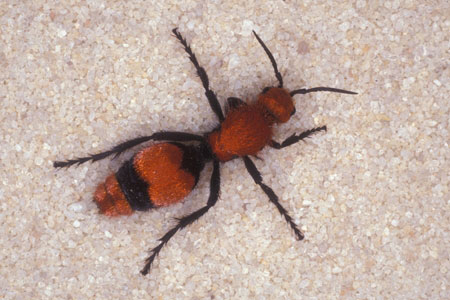Active Seasons




Appearance and Size Facts
- Also known as Cow Killer Ants
- Not actually ants, but are wasps
- Females are wingless and covered with patches of dense, often brightly colored red, orange, brown or white hair
- Adults are sexually dimorphic, meaning that males are always winged but do not have a stinger, while females always lack wings but also possess a stinger
- Velvet ants contain one of the largest and more powerful stings of any hymenopteran insect
- Size: Ranges from 1/8 to 1 inch long
We service for velvet ants in the following locations and their surrounding areas:

Behavior and Habitat of Velvet Ants
Velvet ants are active during the day, and they may be some of the first insects to begin foraging in the morning. They will retreat from high ground temperatures in the middle of the day by burrowing under debris, or climbing into plants. They prefer to feed on plant nectar.
Velvet ants are also known as cow killers or mule killers because of their extremely painful sting. Like all wasps, they can sting multiple times. Because of their armor-like exoskeleton and painful sting, few, if any, animals consume this conspicuous wasp.
Over 150 species of velvet ants exist throughout the US, southern Canada, and Mexico. They are found in suburban and agricultural areas of South Florida. Velvet ants are solitary wasps, and only the females will be seen wandering about, while males can sometimes be spotted flying around.

Signs of Infestation of Velvet Ants
They lay eggs into the nests of ground dwelling bees and wasps. They make a loud squeak sound when picked up, although this behavior is not advised, as they can and will sting, leaving a very painful experience if handled.

Tips for Prevention of Velvet Ants
Hulett Environmental Services, should be contacted to control the infestation due to the health hazard of the powerful sting.


